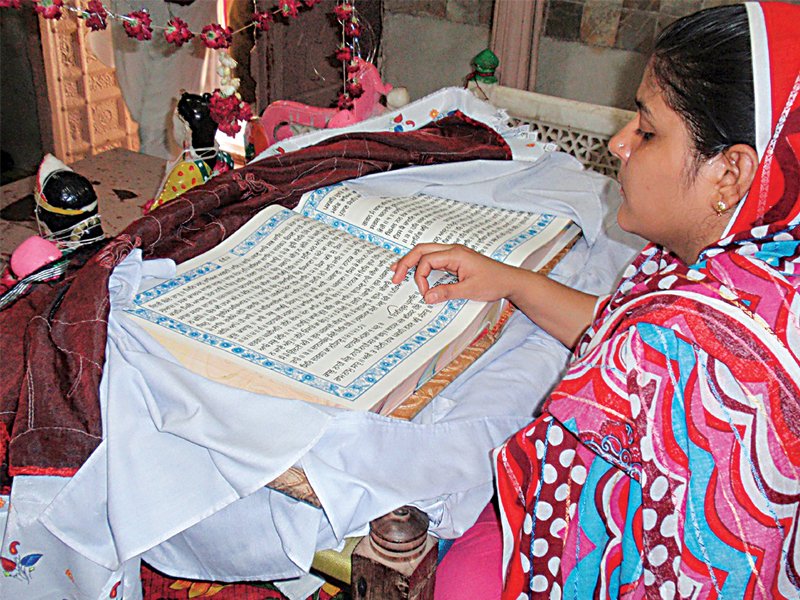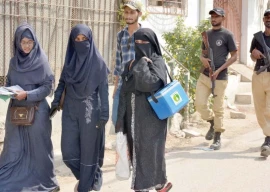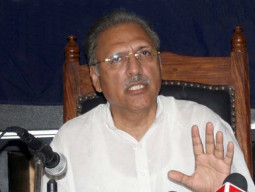
Thousands of Hindu pilgrims from across the country converged at the Sadh Belo temple to pay homage to Maharaj on his 150th death anniversary. The three-day celebration started on Sunday with the Hawan (Agni Pooja) and recitation of Guru Granth and Geeta.

Marble carvings on the walls of Sadh Belo temple in Sukkur. PHOTO: SARFARAZ MEMON/EXPRESS
Vajanti is not alone in her faith in Baba’s prowess to answer prayers. Ladki Devi, a resident of Jacobabad, has been a regular at the temple for the last thirty years but believes purity of heart is a precondition for one’s wishes to be granted. “Thousands of people come here every year and get what they want,” she said as she joined the other worshippers while chanting ‘Hail Baba Bankhandi Maharaj.’
Sadh Belo is located on an island that was previously known as Menak parbat. According to the legend, Baba Bankhandi Maharaj came to the site in 1823 at the age of 15. He lived here till his death at the age of 60. The temple construction was initiated by Sant Harnam Das, Maharaj’s eighth gaddi nasheen, in 1899. According to a temple caretaker, Ashok Kumar, the 10th gaddi nasheen recently died in Haridwar, India, and Swami Vish Darsh Jee Maharaj has been elected as his successor. Kumar said that they follow a very stringent process while electing the gaddi nasheen, adding that he must be honest, dedicated and celibate (udaseen). “This is because they are supposed to have nothing to do with the mortal world.”

The Sadh Belo Parbandhak Committee is responsible for pilgrims’ lodging and food, which is provided for free during the course of the three-day event. Mukesh Kumar, the committee chairperson, said that 25,000 to 30,000 pilgrims can be accommodated in the temple. “Men and women are allotted separate space under the open sky but those who want to live with their families are given a room,” he said. “We have 52 rooms in the temple but we are planning to increase them as the number of pilgrims has swelled over the years.”
The temple, spread over nine acres, houses separate places of worship for men and women, a library with books on religion and Hindu mythology, segregated bhandars (dining rooms) and a huge garden. The administration has also preserved the living quarters of Maharaj and his disciples.
Published in The Express Tribune, June 24th, 2013.
COMMENTS (5)
Comments are moderated and generally will be posted if they are on-topic and not abusive.
For more information, please see our Comments FAQ

















This only is possible in Sindh. Even Hindu population is freely celebrating their religious rituals with peace. Credit goes to Sufi and pluralistic traditions of Sindh. Extremism is burning Pakistan's every city, Sindh is an example of Sufi, moderate religious value. Respect Sindhis!
Vajanti, my little daughter, May your all good wishes, bear fruits. May always Shadow of Baba Bankhandi Maharaj always provide you with His Divine protection.
Have these people not seen how the Char Dham places and devotees were devastated by the Floods in India? If they do not desist from Idol Worship and continue to worship false dieties, they should be ready for similar natural disasters.
Good to see an article presenting religious diversity of Pakistan. Pakistanis need to take greater pride in the fact that they form a multi-ethnic multi-linguistic multi-racial multi-religious country. A nation's strength lies in how well its people acknowledge and celebrate the diversity of their countrymen.
Long live multifaith, multicultural Pakistan. Pakistan of Quaid-e Azam